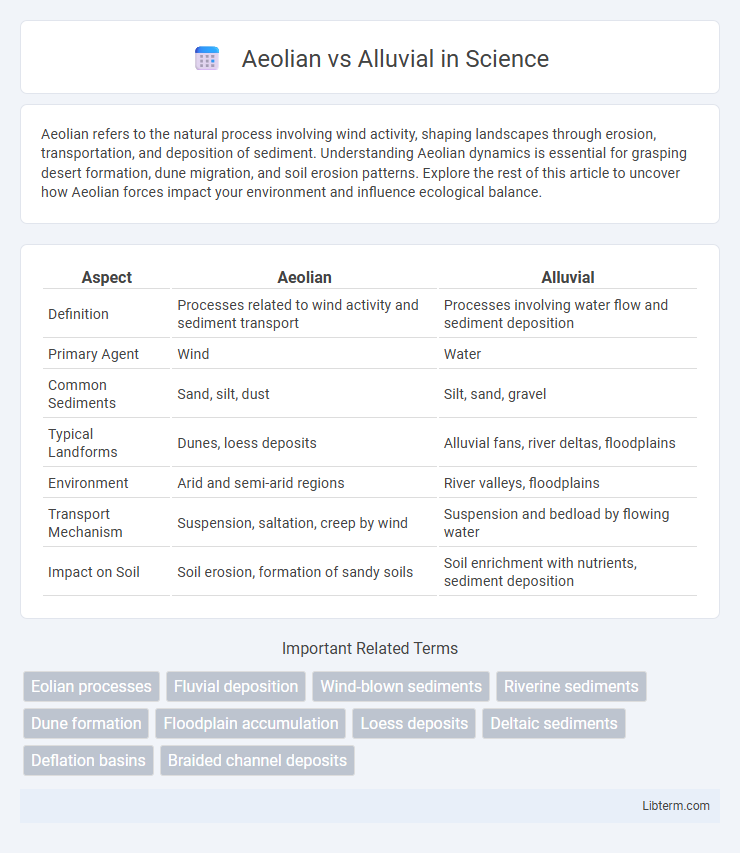Aeolian refers to the natural process involving wind activity, shaping landscapes through erosion, transportation, and deposition of sediment. Understanding Aeolian dynamics is essential for grasping desert formation, dune migration, and soil erosion patterns. Explore the rest of this article to uncover how Aeolian forces impact your environment and influence ecological balance.
Table of Comparison
| Aspect | Aeolian | Alluvial |
|---|---|---|
| Definition | Processes related to wind activity and sediment transport | Processes involving water flow and sediment deposition |
| Primary Agent | Wind | Water |
| Common Sediments | Sand, silt, dust | Silt, sand, gravel |
| Typical Landforms | Dunes, loess deposits | Alluvial fans, river deltas, floodplains |
| Environment | Arid and semi-arid regions | River valleys, floodplains |
| Transport Mechanism | Suspension, saltation, creep by wind | Suspension and bedload by flowing water |
| Impact on Soil | Soil erosion, formation of sandy soils | Soil enrichment with nutrients, sediment deposition |
Introduction to Aeolian and Alluvial Processes
Aeolian processes involve the transportation and deposition of sediments by wind, primarily shaping desert landscapes and coastal dunes. Alluvial processes refer to the movement and sedimentation of particles by flowing water, typically forming riverbeds, floodplains, and deltas. Understanding these mechanisms is crucial for interpreting sedimentary environments and landscape evolution.
Definition of Aeolian Formations
Aeolian formations consist of sedimentary deposits shaped by wind activity, primarily composed of fine sand, silt, and dust particles transported and accumulated in arid and semi-arid environments. These wind-driven deposits create distinct landforms such as dunes, loess blankets, and sand sheets, characterized by well-sorted and rounded grains. In contrast, alluvial formations result from water-driven sedimentation in riverbeds, floodplains, and deltas, involving coarser materials like gravel, sand, and clay carried by running water.
Definition of Alluvial Formations
Alluvial formations are sedimentary deposits created by the action of rivers and streams, typically consisting of materials such as sand, silt, clay, and gravel transported and laid down in floodplains, riverbeds, and deltas. These deposits are characterized by their variable grain size and high fertility, supporting diverse ecosystems and agricultural activities. In contrast, Aeolian formations result from wind-driven processes, involving fine particles like sand and dust accumulating in dunes and loess plains.
Key Differences Between Aeolian and Alluvial Deposits
Aeolian deposits are formed by wind action, characterized by well-sorted, fine to medium sand particles with rounded shapes, commonly found in deserts and dune environments. Alluvial deposits result from water flow, typically containing a mix of clay, silt, sand, and gravel with poorly sorted and often angular particles, deposited in riverbeds, floodplains, and deltas. The primary difference lies in the transport mechanism--wind versus water--affecting particle size, sorting, and sedimentary structures.
Common Landforms Created by Aeolian Processes
Aeolian processes primarily create landforms such as sand dunes, loess deposits, and desert pavements through wind erosion, transportation, and deposition of sediment. Common aeolian landforms include barchan dunes, transverse dunes, and longitudinal dunes, which are shaped by prevailing wind directions and sediment supply. Unlike alluvial landforms formed by water, aeolian landforms occur predominantly in arid and semi-arid environments where wind action dominates.
Typical Landforms Resulting from Alluvial Processes
Alluvial processes typically form fertile floodplains, deltas, river terraces, and alluvial fans due to the deposition of sediment carried by rivers and streams. These landforms are characterized by well-sorted layers of sand, silt, and clay, contributing to rich agricultural soils and diverse ecosystems. Alluvial deposits often create extensive flatlands that support human settlements and infrastructure development.
Environmental Conditions Influencing Aeolian Activity
Aeolian activity is primarily influenced by dry, arid, or semi-arid environments with sparse vegetation, where strong, consistent winds can mobilize and transport fine particles of sand and silt. In contrast, alluvial processes dominate in regions with abundant water flow, such as river valleys and floodplains, where sediment is deposited by moving water rather than wind. The prevalence of aeolian activity is closely tied to factors like low soil moisture, minimal plant cover, and fluctuating wind velocities that facilitate sediment erosion and dune formation.
Environmental Factors Driving Alluvial Processes
Environmental factors driving alluvial processes include the availability of water flow, sediment supply, and terrain gradient. Seasonal rainfall patterns influence river discharge, which transports and deposits alluvial sediments in floodplains and riverbanks. Vegetation cover and land use changes also affect sediment erosion and deposition rates in alluvial environments.
Importance of Aeolian and Alluvial Systems in Geology
Aeolian and alluvial systems are crucial in geology for understanding sediment transport and landscape formation. Aeolian processes shape deserts and coastal dunes by depositing windblown sediments, while alluvial systems influence river valleys and floodplains through water-driven sedimentation. Studying these systems aids in interpreting past climatic conditions, resource distribution, and landform evolution.
Comparative Analysis: Aeolian vs Alluvial Landscapes
Aeolian landscapes are primarily shaped by wind-driven processes, resulting in features like dunes and loess deposits, whereas alluvial landscapes are formed by water action, characterized by river channels, floodplains, and deltas. Aeolian sediments tend to be well-sorted and fine-grained, while alluvial deposits display a wider grain size range due to varying flow velocities. The ecological and agricultural productivity differs as alluvial soils are typically more fertile and support diverse vegetation compared to the often arid and less stable aeolian terrains.
Aeolian Infographic

 libterm.com
libterm.com